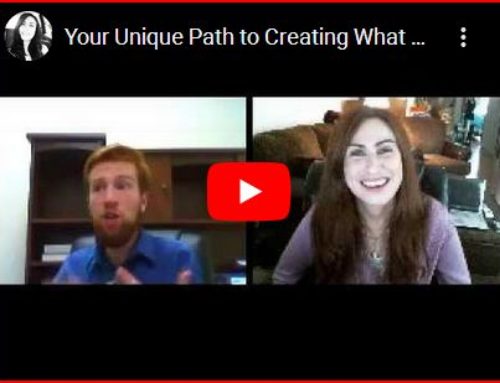Targeted Affirmation Tip #1: Creating Intentions: Intend to Have What You Want
In recent years, there has been a lot of backlash against affirmations. Many people believe that they don’t really work. I believe the reason for this is because many people tried what seemed like a great idea, didn’t do it quite right, and then became discouraged. I’m actually one of those people!
I’ve been getting a lot of questions about affirmations lately, so I decided to revisit this topic.
My Personal Affirmation Failure
I started using affirmations when I was in the seventh grade. I remember having a small book about positive thinking that recommended using affirmations to feel happier and more relaxed. I was feeling very sad and anxious at the time, and repeating the affirmations really wasn’t working for me. I remember reading affirmations to myself like:
“I feel good”
“I deserve to feel good”
“I feel relaxed”
And they really didn’t help me to feel any better. In fact, reading the affirmations frustrated me. I would say the affirmation and just feel worse, because it didn’t match what I was actually feeling. It felt shallow somehow, like I was trying to fix something within me on a surface level without digging deeper.
Have you ever had this experience using affirmations?
Maybe our society and knowledge of how to use techniques like this is evolving, because I don’t remember ever reading anything about how affirmations don’t work, when I was younger. Everyone just seemed so excited to have a new technique to use. There wasn’t a whole lot of talk about how to do it correctly, so that it actually works.
Why Affirmations Don’t Work (Sometimes)
So let’s pick this apart and really analyze what is going on in your mind and emotions when you say affirmations to yourself: You are feeling bad about something in your life that is true in the moment. You create or choose an affirmation that is the opposite of what you are experiencing as being true.
You affirm this statement to yourself: “I have…”, “I am…” Your next thought usually is, “But wait–I don’t, I’m not!”
And an inner conflict gets started. We all have many parts within us with different roles and motivations. One part of you has decided that the affirmation is going to work and wants to experience change. But when you don’t feel the change immediately, another part of you, the snide “gremlin” part, says,” Well that didn’t work. I don’t feel any better or different.”
You counteract with the affirmation, “Yes I will! I have….”, “I am…”
And then you think, “No I don’t.”
And this doesn’t get you anywhere! Another thing going on here is that you may start to feel resistance to your current situation, since it is the opposite of the affirmation. You may even start to resist the affirmation itself if you get frustrated enough that it isn’t working!
Remember: what you resist, persists.
So the magic isn’t in just making the statement. We need to fine tune how we do affirmations with these tips and techniques. Then the magic happens!
Here’s my first tip:
Tip #1: Creating Intentions: Intend to Have What You Want
If you find yourself experiencing an internal conflict like the one outlined above when you state your affirmations, you can simply change the language you are using to “leave the fight.” According to the Law of Attraction, by carrying on with the affirmations by just stating them and experiencing internal conflict, you don’t start to feel any better because you are sending out conflicting vibrations: “I feel better/no I don’t feel better.” You are stuck in a loop. So how do we change this and bring inner harmony into the equation?
~Use the word “intend.”~
The absolute truth is that if you are sitting down and repeating an affirmation, you really do want it to be true or you wouldn’t be doing it in the first place. But your message to yourself and to the Universe is not clear if you are internally arguing with yourself. Project a razor sharp intention by acknowleding simply that you intend for your affirmation to be true. No part of you can argue with that! So your inner dialogue will go like this, for instance:
I intend to relax.
I don’t feel relaxed now/yet.
But I intend to relax”.
In this situation there can still be some resistance from the “gremlin”, that part of you that is overly critical and gets in the way. There won’t be as much though, because there is no force involved. This approach is much softer. It is not an authoritative statement that can be argued with. All of your “inner parts” can agree that your intention is to relax. This is more about accepting your internal state and your truth, so you can create a space within yourself for the affirmation to come true. You can’t create this space if you are fighting with yourself. It requires a solid decision, which is the intention to accept your current state and not resist it. If you are just repeating affirmations in the standard way, you are more likely to create an internal argument and resistance. It is very important to accept the present state you are in, before you can challenge it.
Not accepting your present state would be like trying to take a trip with to a known destination without knowing exactly where you are starting from. It would be kind of hard to get there, wouldn’t it? Saying, “I intend,” helps you accept that you’ve got a journey in front of you. At least you have a clear destination and transportation (your affirmations are one form). And also notice the power in the word “intend.” I’ve noticed that many coaches use the word “intend” while advising on how to use the Law of Attraction. Have you ever heard anyone talk about “creating intentions” when advising people about how to manifest dreams and goals?
It may seem like a simple word change, but it is actually a powerful shift in 2 ways:
1) An intention is a clear statement about what you want, and being clear is half the battle. An intention followed up by a soft, unclenched direct action is often all that is need to manifest your dream
2) The Law of Attraction can be counterintuitive and doesn’t work the right way for you if you’re in the wrong head space. This is the secret to overcoming fears for anxiety too. If you’re afraid of something, it is more helpful to accept the fear and rush toward it in order to get over it and let it go. Then you can make decisions with a clear head. Using the word “intend” works like this too. It means you accept whatever state you are in and that you merely have an intention and are open to a new situation. This gets you out of the conflict and the thought loops, so you can make way for your intention to come true.
A Word of Caution and Some More Inspiration
If you consistently find that you don’t follow through on intentions (with or without use of affirmation), it may be time to reevaluate your commitment to your goal. This means backing up further, maybe even away from affirmations completely for the time being, and taking time to explore “shoulds” and blockages. But keep in mind that even having an intention is a step forward. This is evidenced in the Stages of Quitting Smoking, where even “contemplation” is viewed as a step forward as opposed to someone who does not intend to quit anytime soon.
Please leave a comment below and share how this tip works for you!






